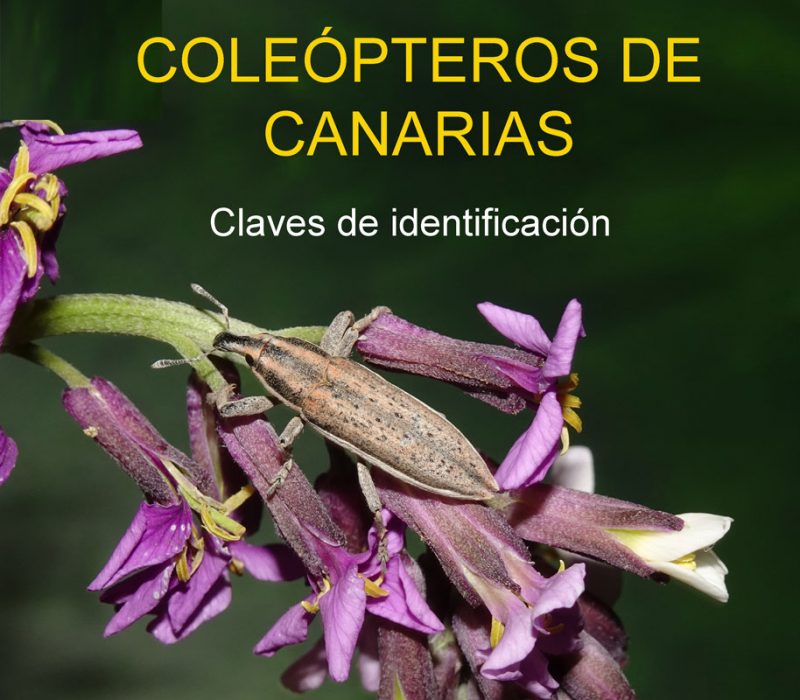ALERT – If you are interested in receiving a message every time I update a family, send me an email with the subject “Keys to Canarian coleoptera”, and just say “I am interested”.
My email: antonio.machado@telefonica.net.
KEYS TO CANARY ISLANDS COLEOPTERA
These keys have been compiled from those available from other authors, if any, adapting them to the fauna of the Canary Islands and complementing or substituting them as necessary. Practical criteria have prevailed over systematic ones (kinship relationships), so they must be used with due caution. Taxa hitherto uncited for the Canary Islands may end up being determined as what they are not, although some specific characters have been included in the hope of avoiding this.
The families recognised basically follow the taxonomic scheme adopted in the Catalogue of Palaearctic Coleoptera, although the respective family keys are numbered in alphabetical order. I am afraid that the keys are only available in Spanish. The PDF files are listed with with the date of edition to reflect the latest update).
Feel free to download and use these keys. If you find any errors in the texts or images, if you miss any species, or if you wish to make any suggestions or send missing images, please do not hesitate to write to me at antonio.machado@telefonica.net.
Special recognition goes to my dear colleagues Prof. Dr Pedro Oromí, Rafael García and Roberto Valle who have been testing the keys and provided timely comments. Thanks also to the authors of the photos who have consented to their use in these keys.
Recommendation for use
But if you are used to printed keys, I recommend using ring binders with plastic sleeves for A4 sheets. The ring binder allows you to fold the notebook and reduce its width so that it can be placed next to the magnifying glass.
Print the keys in colour on one side of the paper only (this makes it easier to replace individual sheets). These notebooks are available in different thicknesses (20, 30, 40 and 50 sleeves), external colours and with or without an external pocket to include a cover page.
The families are in alphabetical order, but it is still practical to separate the extensive and frequently consulted families into individual notebooks. As an example, here is how I have combined them.
- Black notebook (50 sleeves) – Introduction, general keys and families A to C (with list on the cover)
- Orange notebook (30 sleeves) – Families D to L (with list on the cover)
- Red notebook (40 sleeves) – Families M to Z (with list on the cover)
- Blue notebook (30 sleeves) – Carabidae
- Green notebook (30 sleeves) – Curculionidae (with cover)
- Green notebook (30 sleeves) – Curculionidae Entiminae.
- Black notebook (20 sleeves) – Tenebrionidae
- Pink notebook (40 sleeves) – Staphylinidae
- Purple notebook (20 sleeves) – Checklist and bibliography (with cover)
MACHADO, A. (2023-2025). Coleópteros de Canarias. Claves de identificación.
https://www.antoniomachado.net/es/claves-coleopteros-canarias/ (date consulted)
| Nº | Content | Taxa. | Updated | To download |
| Introducción | – | Ago 2025 | ||
| Clave de familias | 70 | Jul 2025 | ||
| 1 | Aderidae | 5 | Nov 2023 | |
| 2 | Anthicidae | 32 | Jul 2025 | |
| 3 | Anthribidae | 3 | Oct 2023 | |
| 4 | Attelabidae | 4 | Jul 2025 | |
| 5 | Belidae | 2 | Oct 2023 | |
| 6 | Biphyllidae | 3 | Jul 2025 | |
| 7 | Bostrichidae | 13 | Oct 2023 | |
| 8 | Bothrideridae | 2 | Jul 2025 | |
| 9 | Brentidae | 27 | Jun 2024 | |
| 10 | Buprestidae | 22 | Ene 2024 | |
| 11 | Byrrhidae | 6 | Oct 2023 | |
| 12 | Cantharidae | 12 | Nov 2023 | |
| 13 | Carabidae | 259 | May 2025 | |
| 14 | Cerambycidae | 28 | Ago 2025 | |
| 15 | Cerylonidae | 1 | Nov 2023 | |
| 16 | Chrysomelidae | 113 | Jul 2025 | |
| 17 | Ciidae | 6 | Oct 2023 | |
| 18 | Clambidae | 3 | Oct 2023 | |
| 19 | Cleridae | 7 | Apr 2024 | |
| 20 | Coccinellidae | 61 | Jul 2025 | |
| 21 | Corylophidae | 12 | Jul 2025 | |
| 22 | Cryptophagidae | 29 | Jul 2025 | |
| 23 | Cucujidae | 2 | Oct 2023 | |
| 24 | Curculionidae |
603 | Ago 2025 | |
| 25 | Dasytidae | 14 | Oct 2023 | |
| 26 | Dermestidae | 34 | Jul 2025 | |
| 27 | Dryopidae | 1 | Ene 2024 | |
| 28 | Dytiscidae | 22 | Dic 2023 | |
| 29 | Elateridae | 53 | Nov 2024 | |
| 30 | Endomychidae | 14 | Jul 2025 | |
| 31 | Erotylidae | 2 | Oct 2023 | |
| 32 | Eucinetidae | 1 | Oct 2023 | |
| 33 | Eucnemidae | 1 | Oct 2023 | |
| 34 | Gyrinidae | 3 | Oct 2023 | |
| 35 | Haliplidae | 1 | Oct 2023 | |
| 36 | Helophoridae | 1 | Dic 2023 | |
| 37 | Histeridae | 45 | Jul 2025 | |
| 38 | Hydraenidae | 16 | Jul 2025 | |
| 39 | Hydrochidae | 1 | Dic 2023 | |
| 40 | Hydrophilidae | 20 | Dic 2023 | |
| 41 | Jacobsoniidae | 1 | Apr 2024 | |
| 42 | Kateretidae | 5 | Oct 2023 | |
| 43 | Laemophloeidae | 4 | Oct 2023 | |
| 44 | Languriidae | 5 | Jul 2025 | |
| 45 | Latridiidae | 30 | Jul 2025 | |
| 46 | Leiodidae | 19 | Jan 2024 | |
| 47 | Malachiidae | 83 | Jul 2025 | |
| 48 | Meloidae | 10 | Dic 2023 | |
| 49 | Melyridae | 3 | Nov 2023 | |
| 50 | Monotomidae | 11 | Jul 2025 | |
| 51 | Mordellidae | 8 | Nov 2023 | |
| 52 | Mycetophagidae | 4 | Jul 2025 | |
| 53 | Nitidulidae | 37 | Jul 2025 | |
| 54 | Oedemeridae | 12 | Jul 2025 | |
| 55 | Phalacridae | 7 | Nov 2023 | |
| 56 | Ptiliidae | 23 | Jul 2025 | |
| 57 | Ptilodactylidae | 1 | Jul 2025 | |
| 58 | Ptinidae | 78 | Jul 2025 | |
| 59 | Salpingidae | 2 | Jul 2025 | |
| 60 | Scarabaeidae | 44 | Jul 2025 | |
| 61 | Scirtidae | 1 | Jul 2025 | |
| 62 | Scraptiidae | 4 | Jul 2025 | |
| 63 | Silphidae | 4 | Jul 2025 | |
| 64 | Silvanidae | 9 | Jul 2025 | |
| 65 | Sphindidae | 1 | Jul 2025 | |
| 66 | Staphylinidae | 357 | Ago 2025 | |
| 67 | Tenebrionidae | 160 | Jun 2025 | |
| 68 | Throscidae | 5 | Jul 2025 | |
| 69 | Trogidae | 3 | Jul 2025 | |
| 70 | Trogossitidae | 10 | Jul 2025 | |
| 71 | Zopheridae | 39 | Jul 2025 | |
| Checklist | 2461 | Ago 2025 | ||
| Bibliografía | Ago 2025 |


